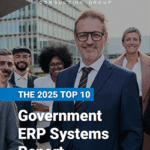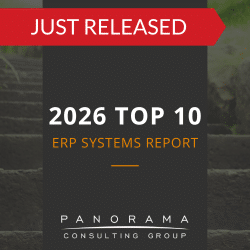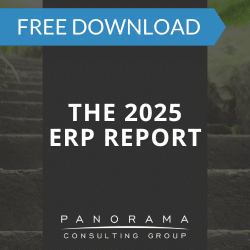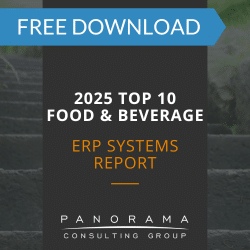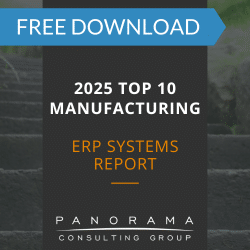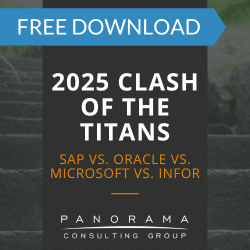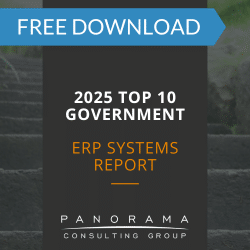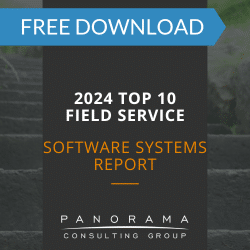- ERP systems play a central role in enabling an autonomous supply chain by supporting data accuracy, cross-functional alignment, and real-time decision execution.
- The success of automated supply chain planning often depends on how well ERP platforms integrate with AI-driven tools and manage transactional follow-through.
- An intelligent supply chain relies on ERP to connect demand forecasts, supplier inputs, production schedules, and financial implications.
- Strategic leadership across governance, talent, and process design determines how effectively ERP supports the shift toward supply chain autonomy.
If you’ve spent any time talking with supply chain leaders lately, you’ve likely heard the same concerns repeated with a new sense of urgency:
Planning cycles feel increasingly irrelevant the moment they’re completed. Forecasts become obsolete in weeks instead of quarters. Inventory swings wildly from shortage to surplus.
What used to be an exercise in optimization has become a daily act of triage.
In response, many companies are implementing autonomous supply chain tools and integrating them with their existing ERP systems.
Today, we’re exploring what it really takes to bring autonomy to supply chain planning in a way that’s grounded, practical, and aligned with how organizations actually work.
The 2025 ERP Report
72.6% of respondents said they've already deployed AI at their organizations. Learn about AI adoption and other ERP trends by downloading our latest report.
The Intersection of ERP and Autonomous Supply Chain Planning
Autonomous supply chain planning depends on the flow of timely, accurate data and the ability to make decisions with minimal human input.
At first glance, this sounds like a technical challenge. In reality, it’s an architectural and governance issue—one that your ERP platform either supports or hinders.
Here are five essential reasons why your ERP system plays a central role in enabling an intelligent supply chain:
1. ERP is the foundation for data governance and process standardization
Before any supply chain planning engine can self-correct or self-optimize, it needs clean, structured data and consistent business processes.
- Data Governance: ERP systems, especially those that have been properly configured and adopted across business units, serve as the system of record for inventory levels, order commitments, supplier lead times, and cost structures.
- Process Standardization: ERP enforces process discipline by defining operational standards and harmonizing purchasing, production, and fulfillment workflows.
2. ERP acts as the backbone for real-time decision execution
Autonomous supply chain models rely on rapid decisions, but those decisions are meaningless unless they can be executed instantly.
For instance, if an AI-based planning system detects a delay in steel delivery and recommends shifting production to a different facility, the ERP system can immediately issue updated work orders, reschedule machine time, reassign welders or machinists, and trigger revised freight instructions.
That translation happens in your ERP system. Top ERP systems increasingly support machine learning, real-time data connections, and event-based triggers that allow supply chain systems to make and act on decisions without human involvement.
3. ERP platforms can support embedded intelligence—but a caveat
Many ERP vendors offer intelligent supply chain modules: embedded AI that can forecast demand, simulate scenarios, and optimize inventory policies.
One caveat: While native tools from ERP vendors do offer tight integration, they may not match the sophistication of specialized autonomous planning platforms. Independent ERP consultants can help you evaluate whether you need a full autonomous supply chain suite, or whether selective upgrades within your current ERP are enough to move the needle.
4. ERP enables the cross-functional alignment critical to autonomous planning
Automated supply chain planning touches finance, sales, engineering, and compliance. If you want a truly autonomous model, you need to break down functional silos.
ERP systems are uniquely positioned to unify these domains. They link sales forecasts with production planning, tie purchasing decisions to vendor compliance, and connect inventory data with financial reporting. This convergence allows machine learning models to make decisions with full context.
For example, if a spike in demand for a seasonal product triggers a new production run, an ERP solution can automatically align raw material purchases with preferred supplier contracts, confirm packaging line availability, and update projected margins in financial reports.
5. ERP gives you a controlled environment for testing and scaling automation
ERP platforms, particularly those with workflow engines and sandbox environments, let you experiment. You can pilot autonomous planning in a single region or product line, monitor performance, and expand based on real impact.
This is where cloud ERP platforms offer an advantage. The elasticity of cloud infrastructure makes it easier to trial advanced planning scenarios without disrupting core operations.
Expert Insight
Migrating to cloud ERP won’t fix flawed planning logic—it will just move it to a different hosting model. The real benefit comes when your technology setup matches how your business actually works and makes decisions.
Strategic Considerations for Executives
To make automated supply chain planning work with ERP, leaders need to focus on four strategic considerations:
1. Reframe your supply chain maturity model
Too many organizations think in terms of linear maturity:
- Manual – processes driven by human judgment and spreadsheets
- Automated – workflows triggered by predefined rules and system alerts
- Autonomous – systems that adapt and act on their own based on real-time data and machine learning
In reality, maturity is multidimensional. You might have automated demand forecasting but rely on tribal knowledge for capacity planning. Or you might have autonomous replenishment tools but still reconcile forecasts manually.
Executives should define what maturity looks like across planning, execution, and reporting—then use ERP capabilities to support those shifts incrementally.
Our ERP application consultants have seen many organizations invest heavily in demand forecasting while keeping production planning more rule-based. This often reflects differences in product complexity, customer expectations, or regional market needs.
Regardless of your focus, the goal is to direct digital investment where it will have the greatest impact, rather than chasing innovation for its own sake.
2. Avoid ERP overreliance by insisting on independent guidance
An ERP vendor may pitch its native planning module as a one-stop solution. While this may sound convenient, there may be better-fit alternatives from other providers.
An independent ERP selection consultant can help you compare the vendor’s roadmap with other available planning tools—and determine whether your ERP system is equipped to manage just the transactional backbone, take on the intelligence layer, or serve both roles effectively.
3. Invest in talent that can translate algorithms into business logic
Autonomous systems require careful testing, ongoing monitoring, and thoughtful interpretation.
While algorithms can make decisions in real time and ERP systems can automate transactions, those actions aren’t enough to transform your business. Without involvement from skilled analysts and planners, autonomous tools may be disconnected from financial targets, customer commitments, and operational constraints.
You need people who can understand both the logic behind the automation and the ripple effects it can have across departments, especially when planning assumptions shift or real-world exceptions arise.
We recommend looking for people who understand data science, business operations, and ERP configurations. This is as important as choosing the right software.
4. Establish digital governance that spans ERP and planning tools
Autonomous planning tools embedded into ERP systems often trigger unintended consequences, such as:
- A change to safety stock levels that affects cash flow
- A demand plan update that disrupts procurement schedules
- An automated inventory transfer that creates shortages elsewhere in the network
Executives must enforce digital governance frameworks that assign clear accountability. Who approves autonomous recommendations? Who audits algorithm performance? Who ensures data quality across systems?
Your ERP system can support these controls through approval workflows, role-based access, and automated alerts—but those features need to be activated and monitored.
For example, a biotechnology company might build dashboards that track overrides to autonomous batch scheduling, helping operations leaders understand where regulatory constraints or clinical priorities are forcing manual intervention.
Learn More About Autonomous Supply Chains
If you’re planning your next software upgrade or reassessing your digital roadmap, don’t fall into the trap of chasing buzzwords. Focus on creating an intelligent supply chain—one that senses, decides, and acts in a way that aligns with how you serve your customers and manage your resources.
Autonomous planning may be the future, but its success depends on what you do with your ERP today. Our ERP evaluation consultants can assess whether your system can truly enable automated and autonomous planning—or if it’s holding you back. Contact us for a free consultation.


